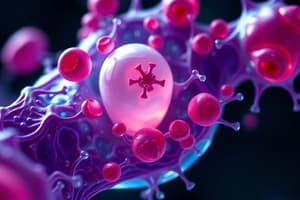Podcast
Questions and Answers
What is the main function of cholesterol in the cell membrane?
What is the main function of cholesterol in the cell membrane?
- To provide a barrier for the cell against the external environment
- To facilitate the movement of particles across the membrane
- To aid in the degradation of proteins embedded in the membrane
- To act as a stabilizer during elevated temperatures and restrict motion (correct)
What is the term for the movement of particles from an area of higher concentration to an area of lower concentration?
What is the term for the movement of particles from an area of higher concentration to an area of lower concentration?
- Diffusion (correct)
- Facilitated diffusion
- Active transport
- Osmosis
Which type of protein is embedded in the cell membrane and facilitates the transport of large molecules?
Which type of protein is embedded in the cell membrane and facilitates the transport of large molecules?
- Lipid proteins
- Integral proteins (correct)
- Glycoproteins
- Peripheral proteins
What is the term for the movement of particles against their concentration gradient, requiring energy expenditure?
What is the term for the movement of particles against their concentration gradient, requiring energy expenditure?
What is the term for a solution that has the same concentration of solutes as the cell?
What is the term for a solution that has the same concentration of solutes as the cell?
What is the term for the process by which the cell takes in large molecules or particles through the formation of vesicles?
What is the term for the process by which the cell takes in large molecules or particles through the formation of vesicles?
What is the primary function of the Golgi complex in the cell?
What is the primary function of the Golgi complex in the cell?
What is the main component of the cytoskeleton that provides structural support and movement within the cell?
What is the main component of the cytoskeleton that provides structural support and movement within the cell?
What is the primary function of aerobic cellular respiration?
What is the primary function of aerobic cellular respiration?
What is the function of microtubule-organizing centers (MTOCs) in the cell?
What is the function of microtubule-organizing centers (MTOCs) in the cell?
What is the primary function of lysosomes in the cell?
What is the primary function of lysosomes in the cell?
What is the role of centrioles in the cell?
What is the role of centrioles in the cell?
Flashcards are hidden until you start studying
Study Notes
Cytosol and Endoplasmic Reticulum
- Cytosol: fluid portion of the cell
- Endoplasmic Reticulum (ER): modifies and transports proteins after they're made
- Rough ER: portion with attached ribosomes
- Smooth ER: no attached ribosomes, responsible for lipid synthesis
Golgi Complex and Lysosomes
- Golgi complex: receives and alters lipids and proteins from ER, ships them to other cell parts
- Lysosomes: contain digestive enzymes to break down waste and harmful materials
Energy and Cellular Respiration
- ATP (adenosine triphosphate): high-energy molecule providing energy for the cell
- Aerobic cellular respiration: uses oxygen, produces carbon dioxide, water, and ATP
Cytoskeleton
- Cytoskeleton: network of protein fibers providing structural support and movement within the cell
- Contains microtubules and microfilaments
- Microtubules: hollow cylinders involved in chromosome movement during cell division and cilia/flagella structure
- MTOCs (microtubule-organizing centers): microtubules grow outward from here to assist in chromosome movement
- Centrioles: inside centrosomes, form hollow cylinders, assist in microtubule assembly
- Microfilaments: two intertwined chains of actin, work with myosin to cause cell constriction and muscle contraction
Cell Coat and Membrane
- Cell coat: made up of polysaccharide side chains, glycoproteins, lipids, and extracellular matrix fluid
- Mosaic model: phospholipid bilayer with embedded proteins
- Membrane components: lipids (amphipathic phospholipids, cholesterol) and proteins (peripheral, integral)
- Selective permeability: allows only certain materials to pass through the membrane
Transport
- Diffusion: passive transport, along concentration gradient
- Active transport: requires energy expenditure, moves particles against concentration gradient
- Special methods: endocytosis and exocytosis
- Diffusion principles:
- Osmosis: equalizes solute concentrations
- Isotonic: equal solutes inside and outside
- Hypertonic: more solutes outside the cell
- Hypotonic: more solutes inside the cell
- Facilitated diffusion: diffusion of large, lipid-insoluble molecules using integral proteins
Studying That Suits You
Use AI to generate personalized quizzes and flashcards to suit your learning preferences.




